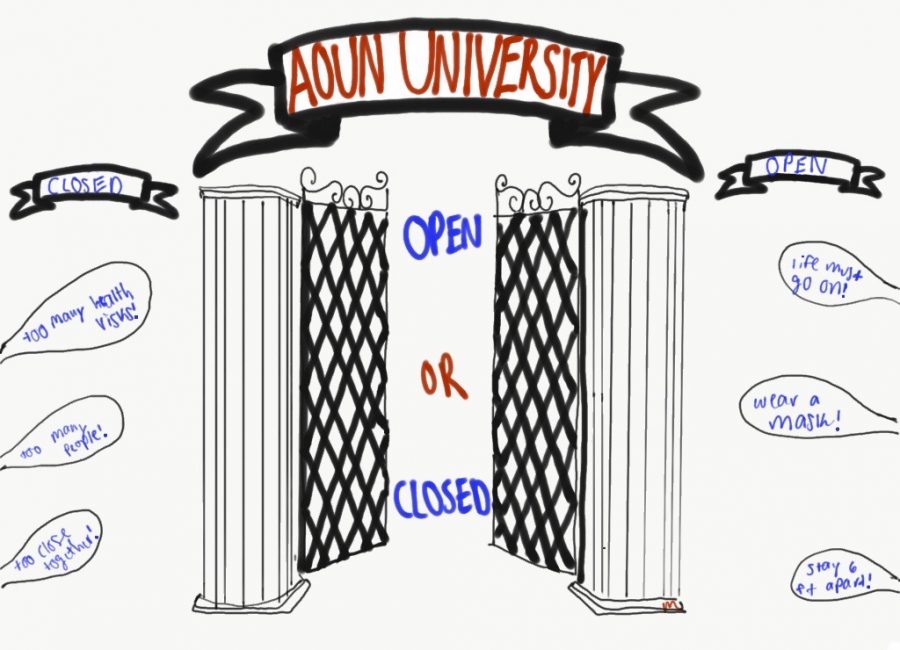Op-ed: Who is responsible for a COVID-19 outbreak at Northeastern?
Illustration by Madison Boudreau Popovic
Northeastern and the surrounding community voice their concerns surrounding reopening campus.
August 30, 2020
In late August, a student-run Northeastern class of 2024 Instagram account posted a story poll asking students if they intend to party, promising anonymity. The owner of the Instagram account then forwarded the usernames to Northeastern administration. While not the purpose of this op-ed, the choice to forward poll responses and usernames is a reminder that digital spaces are almost never anonymous. Students who responded “Hell Yeah” received an email shortly after, condemning their responses and demanding they follow a list of steps, or else their offers would be rescinded.
Northeastern’s Senior Vice Chancellor for Student Affairs Madeleine Estabrook sent a “Response to Unsafe Behaviors” email to the larger Northeastern community a day later, urging anyone to report unsafe behavior and for each person to take responsibility in keeping us all safe. A few individuals’ choices could lead to an entire outbreak, devastating both the Northeastern and the surrounding communities.
The discourse surrounding these events on Northeastern student social media platforms celebrated Northeastern’s quick and serious response to the potential parties. But is the spread of the virus just the responsibility of the individuals who choose to break safety protocols?
There are different levels of protection offered by Northeastern’s reopening plan. Northeastern faculty were given the option to return to campus or stay remote, and less than one third accepted the option to stay remote. Undergraduate and graduate students have the same option to remain remote or return to campus; however, during a recent union meeting, some graduate students expressed uncertainty regarding whether or not they are required to return to campus.
Then there are essential workers on campus who are disinfecting, cleaning and making campus as safe as possible for students. These workers take public transportation, walk and drive. They have family members who may also be essential workers. And they do not have a choice to work if they want to maintain their incomes. Some may also live in the communities surrounding Northeastern, like Roxbury, a predominantly Black and Latinx neighborhood.
The Data for Justice Project shows a correlation between essential workers, positive COVID-19 rates, and racial demographics in Boston neighborhoods. Black and Latinx communities, according to Centers for Disease Control and Prevention data, are much more likely to be impacted by COVID-19 because “many of them have front-line jobs that keep them from working at home; rely on public transportation; or live in cramped apartments or multigenerational homes.” While Northeastern has provided options for faculty and students, essential workers must choose between losing their jobs or continuing to work in unsafe conditions.
Central Michigan University, Notre Dame and The University of North Carolina at Chapel Hill have already demonstrated how quickly the virus spreads on campuses. In response, colleges with growing positive rates are either inputting restraints on campus or closing campuses once again. But even if there are no parties and everyone follows protocols, there is still a chance of an outbreak. We will probably watch positive cases rise live on the Northeastern Reopening Testing Dashboard. What, then, is Northeastern’s plan? How long until we transition back to online learning? At this point, we all acknowledge and recognize the risk of reopening, and we are going through with it anyway.
Instead of chastising individual students, I urge everyone to recognize how larger institutional systems in the United States have failed us. Essential workers are forced to risk their lives and their families’ lives to make ends meet. Stimulus packages received in April covered maybe one to two months’ rent, and another stimulus package may not even be coming.For the first few months of the pandemic, there was a shortage of testing kits, which is still the case in Black and Latinx neighborhoods. Resources such as telemedicine have become more inaccessible and widened the digital divide. Childcare remains unavailable to many working parents. All of these factors and more have led to the United States’ current situation. Yet when educational institutions across the country were given the choice to reopen or protect the health of students and the surrounding community, they chose to reopen.
Northeastern can still take accountability and act as a model for educational institutions across the country. Some steps to protect students, faculty, staff, essential workers and members of the surrounding community include:
• Rethink online and remote courses: Return to online courses and implement smaller class sizes to increase interaction in digital spaces. While transferring to remote-only courses is not ideal, this will help prevent potential outbreaks. Lower class capacities allow everyone to build stronger relationships and increase the number of hired lecturers needed, providing temporary support for educators who were laid off by budget cuts around the nation. As Northeastern’s support for the Immigration and Customs Enforcement lawsuit showed, they have the means to protect vulnerable students, particularly international students who make up 35.3 percent of the student population, and provide relief resources for low-income students.
• Protect essential workers: Provide all essential Northeastern workers with healthcare, a permanent paycheck increase, childcare, shuttle transportation from home to work and at least two weeks of paid sick leave. This also includes continuing to financially help the almost 400 workers laid off or placed on temporary leave in April.
• Protect surrounding neighborhoods: Reallocate resources including economic support, technology, free testing, transportation and healthcare/telehealth into surrounding Boston neighborhoods. Currently, testing is only available to those who are part of the Northeastern community. By reallocating testing and other important resources to community members, Northeastern can help mitigate potential spread to these neighborhoods.
Northeastern asks individual students to protect the pack. I ask Northeastern, instead, to shoulder the responsibility and protect the community.
Cara Marta Messina is a fifth-year PhD candidate in English with a focus on writing and rhetoric at Northeastern University. She can be reached at messina.c@northeastern.edu.







